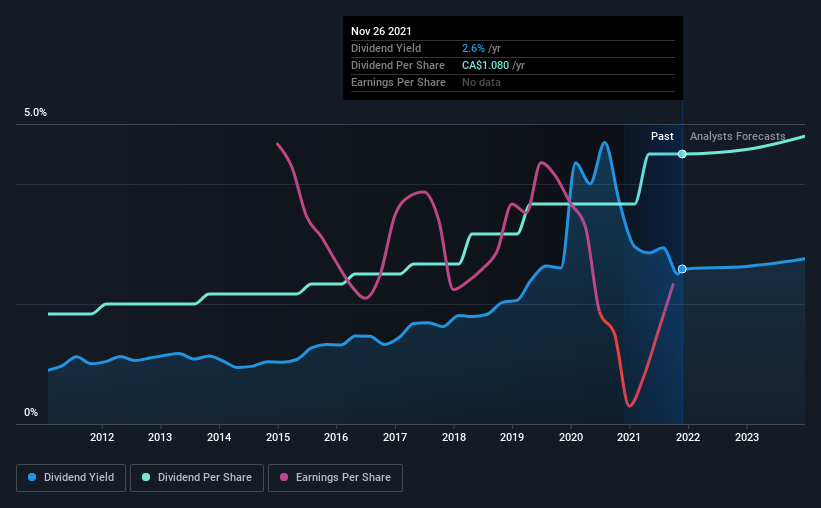Why It Might Not Make Sense To Buy Imperial Oil Limited (TSE:IMO) For Its Upcoming Dividend
Imperial Oil Limited (TSE:IMO) is about to trade ex-dividend in the next four days. The ex-dividend date is usually set to be one business day before the record date which is the cut-off date on which you must be present on the company's books as a shareholder in order to receive the dividend. The ex-dividend date is important as the process of settlement involves two full business days. So if you miss that date, you would not show up on the company's books on the record date. Thus, you can purchase Imperial Oil's shares before the 2nd of December in order to receive the dividend, which the company will pay on the 1st of January.
The company's next dividend payment will be CA$0.27 per share. Last year, in total, the company distributed CA$1.08 to shareholders. Based on the last year's worth of payments, Imperial Oil has a trailing yield of 2.6% on the current stock price of CA$41.79. If you buy this business for its dividend, you should have an idea of whether Imperial Oil's dividend is reliable and sustainable. So we need to investigate whether Imperial Oil can afford its dividend, and if the dividend could grow.
View our latest analysis for Imperial Oil
Dividends are typically paid from company earnings. If a company pays more in dividends than it earned in profit, then the dividend could be unsustainable. Imperial Oil distributed an unsustainably high 136% of its profit as dividends to shareholders last year. Without extenuating circumstances, we'd consider the dividend at risk of a cut. That said, even highly profitable companies sometimes might not generate enough cash to pay the dividend, which is why we should always check if the dividend is covered by cash flow. What's good is that dividends were well covered by free cash flow, with the company paying out 21% of its cash flow last year.
It's good to see that while Imperial Oil's dividends were not covered by profits, at least they are affordable from a cash perspective. Still, if the company repeatedly paid a dividend greater than its profits, we'd be concerned. Extraordinarily few companies are capable of persistently paying a dividend that is greater than their profits.
Click here to see the company's payout ratio, plus analyst estimates of its future dividends.
Have Earnings And Dividends Been Growing?
When earnings decline, dividend companies become much harder to analyse and own safely. If business enters a downturn and the dividend is cut, the company could see its value fall precipitously. Readers will understand then, why we're concerned to see Imperial Oil's earnings per share have dropped 11% a year over the past five years. Ultimately, when earnings per share decline, the size of the pie from which dividends can be paid, shrinks.
Another key way to measure a company's dividend prospects is by measuring its historical rate of dividend growth. Since the start of our data, 10 years ago, Imperial Oil has lifted its dividend by approximately 9.4% a year on average. That's intriguing, but the combination of growing dividends despite declining earnings can typically only be achieved by paying out a larger percentage of profits. Imperial Oil is already paying out a high percentage of its income, so without earnings growth, we're doubtful of whether this dividend will grow much in the future.
To Sum It Up
Is Imperial Oil worth buying for its dividend? It's never great to see earnings per share declining, especially when a company is paying out 136% of its profit as dividends, which we feel is uncomfortably high. However, the cash payout ratio was much lower - good news from a dividend perspective - which makes us wonder why there is such a mis-match between income and cashflow. It's not the most attractive proposition from a dividend perspective, and we'd probably give this one a miss for now.
With that being said, if you're still considering Imperial Oil as an investment, you'll find it beneficial to know what risks this stock is facing. For example - Imperial Oil has 2 warning signs we think you should be aware of.
We wouldn't recommend just buying the first dividend stock you see, though. Here's a list of interesting dividend stocks with a greater than 2% yield and an upcoming dividend.
This article by Simply Wall St is general in nature. We provide commentary based on historical data and analyst forecasts only using an unbiased methodology and our articles are not intended to be financial advice. It does not constitute a recommendation to buy or sell any stock, and does not take account of your objectives, or your financial situation. We aim to bring you long-term focused analysis driven by fundamental data. Note that our analysis may not factor in the latest price-sensitive company announcements or qualitative material. Simply Wall St has no position in any stocks mentioned.
Have feedback on this article? Concerned about the content? Get in touch with us directly. Alternatively, email editorial-team (at) simplywallst.com.

 Yahoo Finance
Yahoo Finance 
